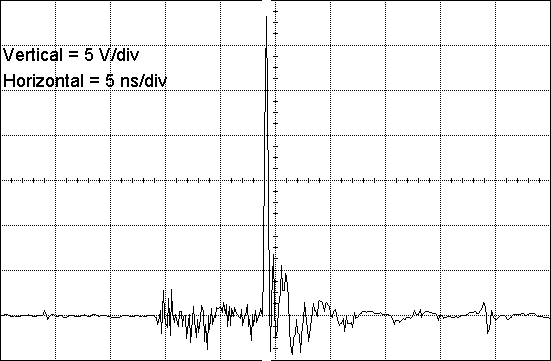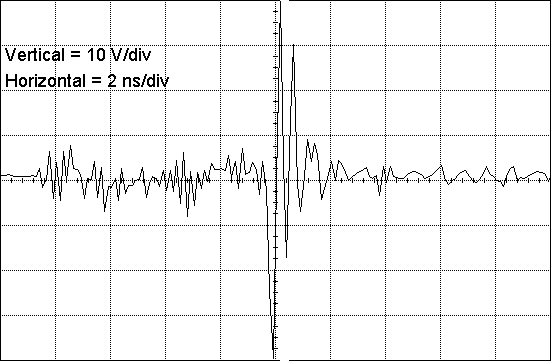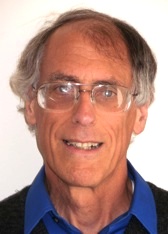
Figure 1. An Impulse with Radiated EMI Preceding It
Abstract: Measurement of high
amplitude impulsive signals, such as ESD, can incur errors due to
radiated effects. The characteristics of these effects are discussed
and ways to spot such errors in a measurement are given.
Discussion: Figure 1 shows an example of an impulse accompanied by radiated EMI, electromagnetic interference, from the impulse source itself. Note the high frequency noise in the waveform preceding the main impulse. Although it is possible the waveform represents the true source, more likely, the high frequency noise before the pulse represents error in the measurement.
The noise starts about 10 nanoseconds before the impulse. In this case, the EMI generated by the impulse radiated into the end of the cable at the scope. The impulse itself traveled down the cable at a slower speed (~1.5 ns/foot) while the radiated EMI traveled faster in space (~1 ns/ft) and through a more direct route to the scope input, arriving at the scope about 10 nanoseconds earlier than the impulse itself. Noise like this on a waveform, occurring before an impulse, often is a sign of direct radiated interference into the measurement. Figure 2 shows another example where the noise starts about eight nanoseconds before the impulse.

Figure 2. Another Impulse with Radiated EMI Preceding It
Mechanisms whereby radiated EMI can affect a measurement in this way include:
Discussion: Figure 1 shows an example of an impulse accompanied by radiated EMI, electromagnetic interference, from the impulse source itself. Note the high frequency noise in the waveform preceding the main impulse. Although it is possible the waveform represents the true source, more likely, the high frequency noise before the pulse represents error in the measurement.
The noise starts about 10 nanoseconds before the impulse. In this case, the EMI generated by the impulse radiated into the end of the cable at the scope. The impulse itself traveled down the cable at a slower speed (~1.5 ns/foot) while the radiated EMI traveled faster in space (~1 ns/ft) and through a more direct route to the scope input, arriving at the scope about 10 nanoseconds earlier than the impulse itself. Noise like this on a waveform, occurring before an impulse, often is a sign of direct radiated interference into the measurement. Figure 2 shows another example where the noise starts about eight nanoseconds before the impulse.

Figure 2. Another Impulse with Radiated EMI Preceding It
Mechanisms whereby radiated EMI can affect a measurement in this way include:
- Poor shield connection at the oscilloscope either because of the connector itself (BNC connectors vary widely in quality) or how the shield interfaces the connector (360 degree, secure connection is best).
- Sometimes an impulsive source like ESD can be powerful enough to leak through the shielding in a scope and directly affect internal circuits of the scope.
- The quality of the shielded cable itself can be an issue. I
have seen BNC cables labeled as RG-58/U that provide poor shielding
effectiveness. In fact, those of you who have attended some of my
seminars/classes have seen an experiment that uses just such a
cable.
- Noise starts before the impulse being measured.
- The noise, as displayed, often contains frequency components that are higher than the rest of the waveform.
- Subsequent events show similar delays between the start of the higher frequency noise and the impulse to be measured.
- The delay between the start of the noise and the impulse is affected by moving the source and/or cable.
Other articles on this website related to interference from impulsive sources are:
- October 2001, The Elusive Glitch
- November 2001, The Elusive Glitch - Part 2
- December 2001, The Elusive Glitch - Part 3, Measurement of Impulsive Fields
If you like the information in this article and others on this website, much more information is available in my courses. Click here to see a listing of upcoming courses on design, measurement, and troubleshooting of chips, circuits, and systems.
Available now for private on-site delivery: my new one day seminar titled: Failure Analysis and Prevention in Electronic Circuits (Design Troubleshooting for the Lab and Field).
Top of page
Home
